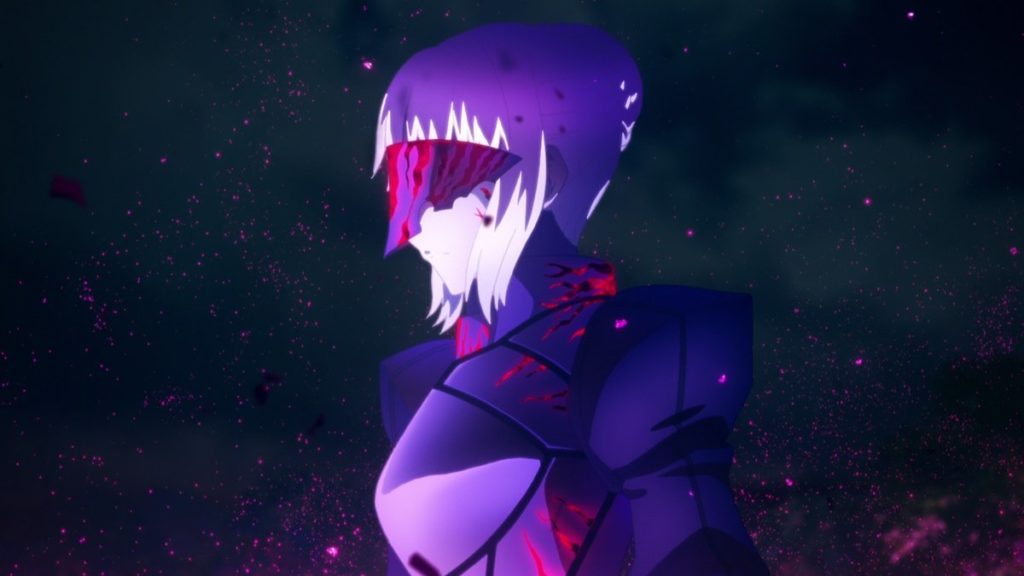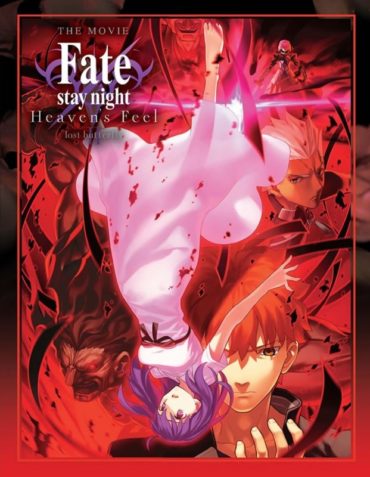Fate/Stay Night Heaven’s Feel II: Lost Butterfly Review
This movie review contains spoilers to the first film as well as talking about some content and two characters that make their debut in this film. Since they’re fan favourites and used extensively on the promotional material for this film, I will be mentioning them by their names and not keep it hidden.
If you wish to not know about any of this, it’s best you go into this movie completely blind.
Shirou has lost Saber, and is no longer a Master in the Holy Grail War, however that doesn’t mean that the ones he cares about are no longer in danger. As soon as he gets home, Shinji threatens Sakura’s life and demands Shirou to come to the school to do battle with his Servant. When Rin makes a surprise attack, it’s revealed that Sakura is the true Master to Rider, not Shinji, and Sakura’s powers are far more dangerous and out of control than expected. But as their relationship deepens, will Shirou keep to his promise to become a ‘Hero of Justice’ or choose to throw them away to protect the one person he loves most?

When it comes to a trilogy, whether it be books or films, the middle entry is often considered to be the less well received of the three and seen to be merely a bridge between the first one (the introduction to the story, building new characters, setting up conflict, etc) and the conclusion (the grand finale, where all the action has been building up to, wrapping up character’s arcs, etc). There are exceptions of course, but because the middle entry can’t conclude anything before the finale, it’s more of a plot driver than a fulfilling entry in its own right. In regards to the plot, one could make this argument for Heaven’s Feel Part II – Lost Butterfly, but the movie has so much more going for it than that. As briefly mentioned in my review for the first film, the Heaven’s Feel story is not only a lot darker but also contains more mature – gore and sexual – content that many believed kept this particular route from being adapted for a very long time. This route also contains the introduction to two fan-favourite characters, darker/evil versions of characters we already know and love, and their entrances happen right smack in the middle of this route. So not only does this movie create high expectations of giving these characters a proper anime movie treatment, but also makes the famous sex scenes worth the wait. The good news is that this film definitely delivers, and continues if not tops the high that the previous film ended on.
Lost Butterfly picks up exactly where the first film left off, so there’s no flashback to what’s happened before or re-introduction to the rules of world of Fate/Stay Night, so I must repeat that this film is absolutely not beginner-friendly. Also because of the aforementioned darker, gorier and sexier scenes, this film isn’t for the faint-hearted, but it’s far more than just style over substance.
The main driving force for this route is the relationship between Shirou and Sakura. It was built up gradually in the first film, but Lost Butterfly is where the scales tip from ‘mutual pining’ to full-on relationship, which is nice to see since the other two routes for Fate didn’t really have Shirou and the respective girl get together until much more towards the end. It’s clear from the dialogue and natural chemistry that they are drawn to each other, and Shirou’s overwhelming need to protect her eclipses Sakura’s darker impulses and self-loathing with a tendency to see herself as not worthy of his love. It’s a darker, unhealthier brand of love than seen previously, but you also can’t help but root for them due to Ufotable’s mastery of framing all their scenes in such a tender and emotional way. However due to Sakura’s backstory and some clunky dialogue, a few of the scenes and intended emotion can become uncomfortable instead. In the original game, rape was haphazardly handed as a mere tool for drama, rather than a delicate situation with actual emotional toll and consequences, so when the story tries to imply that Sakura’s problems can be solved by just having sex with the right person, it can be seen as tone deaf. But to give credit where it’s due, the movie does frame the sex scenes, and the several scenes where Sakura tries to control her sexual urges, very well and it’s tastefully done, with the sex scene shown as a truly intimate act between two people who need each other in the moment, rather than in a pornographic way as in the original release of the visual novel. The rape that occurs in the conclusion is also handled much more delicately than seen in other media. It’s clear that Ufotable tried to make the best of an iffy situation, and sometimes you can’t hide the fact that a scene that was passable in 2004 will not work in the same way in 2020 (or 2019 when this film was first released).

The first film often struggled to balance the tone of the film, as well as its pacing, which became jarring when the movie tried to have its gory battle scenes but also tender moments between the main couple. However, I’m pleased to say that this film does not have that issue; there are plenty of instances where Shirou must balance his home life during the day, and then is thrown into a life-or-death situation at night. But instead of struggling to maintain the two, it all works to really build up the darkness looming and the evil that’s slowly growing inside of Sakura. The moments during the day, where it’s all bright and homely, now feel more precious and sacred, almost as if the characters are in a bubble trying to maintain what little peace they can, because as soon as it’s night, the darkest of evils is ready to tear it all apart. With the main villain of the route slowly growing in power, and starting to take over in daytime, the tender moments become less frequent. When night does fall however, we get some impressive battle scenes and memorable moments with the remaining Servants. The battle between Berserker and Saber Alter may not be impressive in terms of choreography, however the sheer visual display of power between the two is staggering, and we finally get an impressive look at Berserker’s unique power of regeneration. The epic battle plays into the balance of tone and stakes for this movie, as it’s clear that our merely human heroes are absolutely no match for the sheer raw power of these Servants. It’s all hugely effective and the slow burn leading to Dark Sakura’s awakening is so satisfying to see.
So, is this the perfect Fate movie? In terms of adaptation it’s, once again, sticking very close to the material that expands on the appropriate scenes and also cuts out a lot of unnecessary dialogue to help with the flow of the movie. But there are a few minor story choices that hold this movie back from perfection. Not including the already-mentioned clunky dialogue and ‘rape as drama’ uncomfortableness, there are two characters that are quite important to the overall story, and given a good amount of screen time in the beginning of the story, but are seemingly forgotten in the latter half the film. Rider pops in and out of the plot when the director seems fit to remember she’s there, so a few of her scenes that are in the original visual novel are missing. The other fan-favourite character that is introduced in this movie, Saber Alter, is given a fantastic introduction but as soon as the battle is over she disappears completely and we get no real emotional reaction from Shirou or acknowledgement at how her change has affected him or the situation at all, which is such a shame considering how the last film concluded.

Animation is once again provided by Ufotable, and I’m pleased to say that they’ve improved since the last movie; every frame is absolutely stunning and the 3D animation is considerably improved. It’s nicely implemented almost exclusively on the ‘shadow’ and related magic, which gives the dark powers a more ‘otherworldly’ and ‘alien’ feel in contrast to the other magic, rendered in 2D.
Music is provided by Yuki Kajiura, who also scored the previous films, and considering her familiarity with scoring the Fate franchise as well as Type Moon’s other dark material Garden of Sinners, her compositions reflect the mood swings of tender to terrifying with complete ease. But even speaking as a huge Yuki Kajiura fan, I find that there are not many unique pieces that truly stand out or tracks I wish to listen on their own, once the movie is over.
Disc extras contain only trailers for the movie, but if you purchased the collector’s edition of the movie, you’ll also get two artbooks housed in a hardback art box. Both the english and Japanese dubs are included with only English subtitles provided. The English dub contains the same cast as the previous movie, and also carried over from Unlimited Blades Works so these actors are incredibly intune with their characters, and perform wonderfully despite uncomfortable scenes. A special shout out goes to Melissa Fahn as Rider, since her characters has been on the side lines for all of Unlimited Blade Works and the first Heaven’s Feel movie, it’s nice she’s finally able to show off her acting chops in this film where the route showcases her more.
Heaven’s Feel II: Lost Butterfly delivers what Fate/Stay Night fans have been waiting for, with quality animation and fantastic pacing; it fixes all the minor errors that let the previous film down. Although it’s not perfect, it’s a fantastic slow burn with a satisfying dark ending that will leave all viewers desperate to see what the final film has in store. This is not one to pass up, and I really hope that the final movie doesn’t mess up at the last hurdle.


